Written by:@auggest_crypto
tutor:@CryptoScott_ETH, @Zou_Block
TL;DR:
Mobile Network is Heliums mobile network business. Heliums DePIN track is booming, and its wireless communications market is even more promising. The mobile network accounts for 70% of the annual revenue of radio communications and is the main source of market revenue. Therefore, from the perspective of development track, the track to which Mobile Network belongs has huge development potential and high profitability.
Helium will officially complete its migration to Solana in April 2023. While reducing operating costs, it will also rely on Solanas strong explosion and rich ecosystem to bring more user traffic and development space to Mobile Network. Among them, the airdrop incentives and Mapping mining mechanism brought by the Saga mobile phone of the Solana ecosystem have caused a continuous influx of users, which has also indirectly stimulated the user expansion of Mobile Network.
Mobile Network currently accounts for nearly 90% of Helium network usage. As of writing, users consume an average of $2K of DC per day to meet network usage needs. The current operational data is good. Although the number of hotspots and launch time are insufficient and the IoT network is insufficient, it can meet strong user demand coverage.
Mobile Network has the characteristics of low threshold and high coverage, which can stimulate the buying pressure of tokens and the enthusiasm for participation on the supply side, thus forming a positive cycle. This makes $MOBILE expected to be a strong driver in building user awareness for Helium.
1. Mobile Network Project Summary
1.1 Introduction to Mobile Network project
Helium, to which Mobile Network belongs, is a decentralized wireless network with two main businesses: IoT Network ($IOT) and 5G mobile network Mobile Network ($MOBILE).
Helium delivers network deployment to users around the world (People-Powered Networks), providing open, large-scale global wireless network coverage for LoRaWAN standard IoT devices and cellular data standard 5G networks through Hotspot. Any user with an adapted hotspot device can deploy hotspots for network construction and obtain certain mining incentives.
Mobile Network is the mobile network service in the Helium wireless network. Users need to purchase 5G Hotspot and connect CBRS Radios to achieve regional network coverage. The Helium network will incentivize these providers through $MOBILE tokens and crowdsource network infrastructure. Distribute it to all parts of the world to build a powerful 5G network with low cost and wide coverage.
1.2 Mobile Network project details

2. Detailed explanation of Mobile Network project
2.1 Introduction to the Mobile Network team
The number of employees in the team will reach its peak in 2021 with more than 100 employees, with an average tenure of nearly 3 years, and currently there are 11-50 employees on the job.
Abhay Kumar (CEO):
Abhay has been involved in the Helium community since 2019, releasing the first HIP in the summer of 2020, and joined the Nova Labs core development team in the fall of 2020 as chief product officer.
Scott Sigel (COO):
Scott is Heliums chief operating officer and previously served as senior vice president at Silicon Valley Bank. Work closely with start-ups to support their growth, finance and management efforts. It also creates new projects such as API banking, service innovation and product design with the internal RD team.
Amir Haleem (Founder):
Amir is the CEO of Helium Mobile and co-founder of Helium. Prior to joining Helium, Amir had a long career in the video game industry, serving as CTO of gaming startup Diversion and an original Battlefield 1942 team member at DICE in Stockholm, Sweden. Outside of work, Amir is a former world champion esports gamer and co-founder of the popular esports community esreality.com.
2.2 Mobile Network Financing Status
Helium has completed 5 rounds of financing in total, with a total financing amount of 253.8 M. There is currently no financing for the Mobile Network subnet.

2.3 Mobile Network network composition
2.3.1 CBRS Radios
Helium 5G hotspots provide cellular coverage using CBRS (Citizens Broadband Radio Service). CBRS is provided by operators, and Mobile officially cooperates with operators to allow them to provide/support Mobile network connection deployment.
CBRS is generally divided into indoor and outdoor areas. The purchased hotspot equipment can be connected to an indoor or outdoor CBRS cellular radio station. After the connection, the indoor and outdoor networks can be provided accordingly.

Source: tecore.com
However, users need to confirm whether the CBRS radio connected to their 5G hotspot has passed the certification of the operating partner FreedomFi, otherwise even if it is connected, it will not be able to provide Mobile Network network coverage and will not receive mining incentives.
2.3.2 Modeled Coverage
Proof of Coverage verifies that hotspot providers honestly and accurately represent their location, configuration, and created wireless coverage. POC encourages operators to deploy in underserved areas and accurately report their deployments so users can see available coverage.
In the early days of Mobile Network, 5G operators were rewarded simply for keeping their radios online. In order to make the network more reliable and available, Mobile Network introduced Modeled Coverage, a POC proof that is different from other subnetworks.
By introducing more data sources such as zoning and population density to achieve coverage effectiveness, and incentivize operators to deploy in important places. That is, using hexagons in Mobile Networks, the location and number of hotspots within a given hexagon are determined, thereby determining the location of coverage and providing incentives to radios deployed in the best locations.
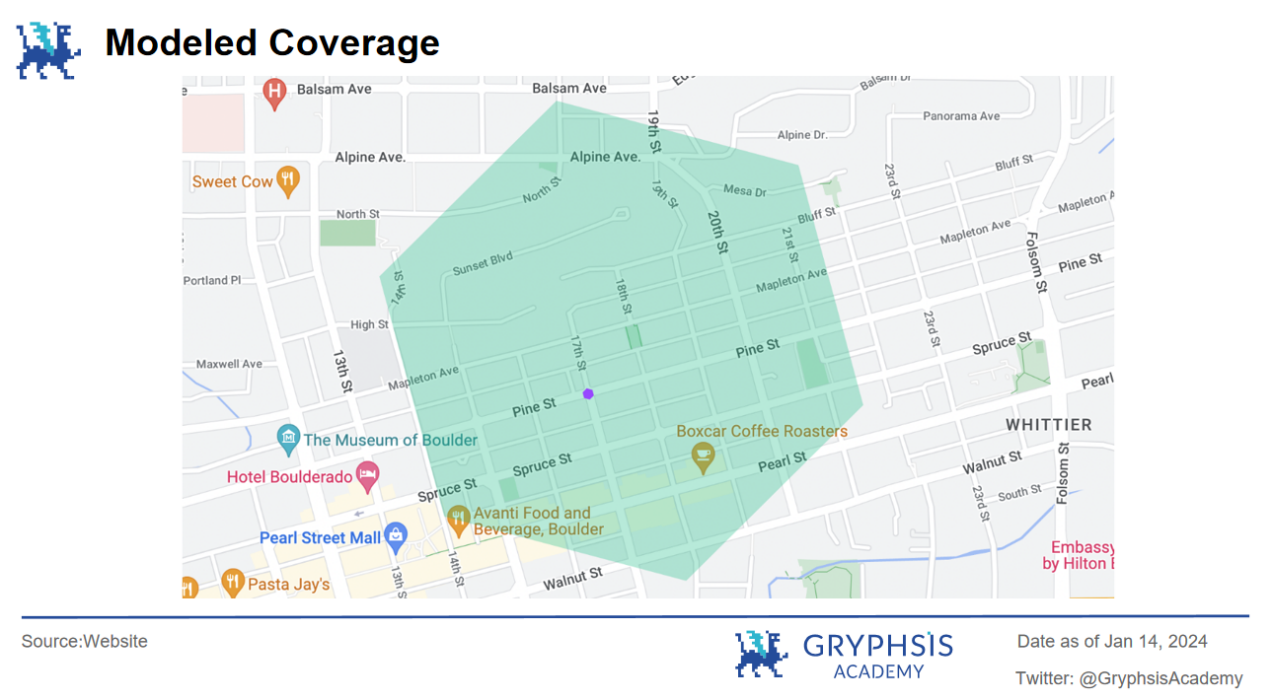
2.3.3 Participants

The Mobile network is mainly composed of subscribers, mappers, service providers, hotspot hosts, hotspot providers and oracles. Among them, service providers, hotspot providers and oracles who want to participate in the network must stake a certain amount of $MOBILE tokens and receive staking rewards.
Hotspot providers: hold at least 50 M $MOBILE; service providers: hold at least 500 M $MOBILE. Service providers are allowed/encouraged to use their access to the $MOBILE drain pool to grow their subscriber base.Mobile Network also gives service providers a 20% incentive on network$MOBILE emissions, thereby attracting users to participate in the Helium 5G network to obtain rewards.
Helium Mobile (mobile phone subscription service) is one of the service providers, through an innovative mobile operator model, incentivizing users to participate in network coverage construction, and using cryptoeconomics to reduce costs and increase revenue.
The following is a brief workflow of Mobile Network: Mapper obtains rewards by verifying Hotspot operator coverage network for POC certification; operators will also receive network incentives after successfully passing verification; Mobile Network is operated by Service Provider to encourage more people to use the network.
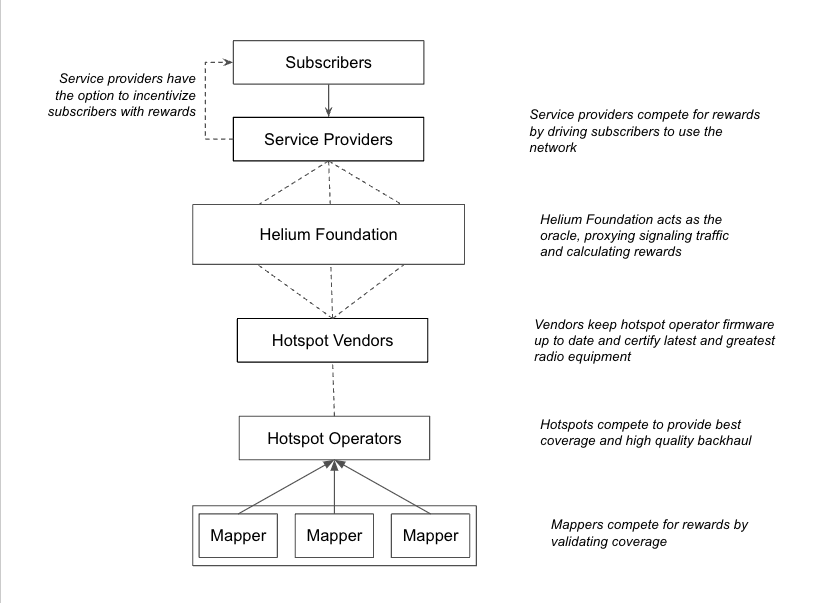
Source: Offical Doc
2.4 Mobile Network products and services
Helium Mobile Network is Heliums subnetwork, focusing on achieving 5G network coverage. Users need to purchase 5G Hotspot and CBRS Radios to achieve regional network coverage.
Mobile Network allows users to purchase exclusive hotspot equipment to provide the network. The equipment can be purchased through the large hotspot operator stores that Mobile currently cooperates with, such as Bobcat, Calchip, FreedomFi, etc., which all provide corresponding equipment.
If you want to use the Mobile network as a consumer, you can purchase a SIM card from a network operator such as FreedomFi to enjoy the Helium 5G network. The network fee is used by burning DC (Proof of Traffic) in $MOBILE.
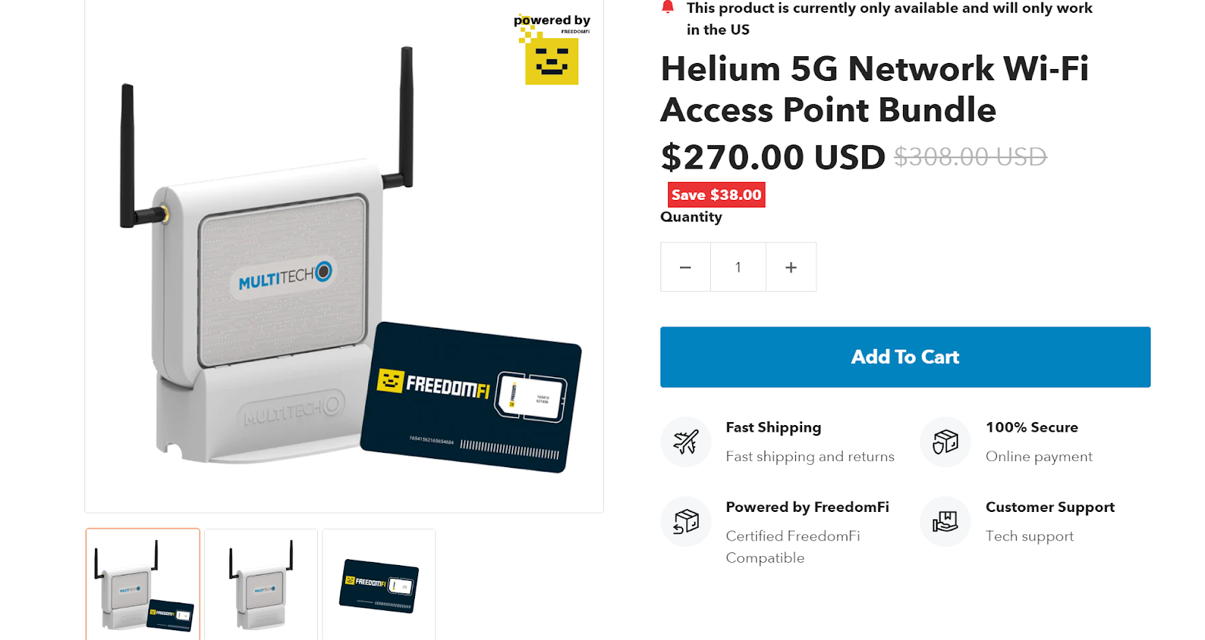
Source: FreedomFi Website
In addition, it has launched its own mobile subscription revenue service Helium Mobile across the United States, built on the Helium Network and launched on Saga (Solana blockchain launch) mobile phone. The wireless phone service, which allows users to earn crypto tokens through daily use, is currently being piloted in Miami.
Helium Mobile subscribers, via"Mapping for Helium"Earn $MOBILE rewards. The “Discovery Mapping” section allows users to understand which areas are covered through location sharing. Therefore, Mapping mapping can be understood as empowering you to collect location information to enhance the Helium Mobile Network and help Helium discover ideal locations for deploying new network coverage. In return, users receive $MOBILE tokens, which can also be used to pay for monthly subscription fees.

Since the launch of the Helium Mobile service, 7,256 online CBRS Radios have been deployed in the United States. The total number of users has continued to rise, especially since December. The number of daily new subscribers has increased to a new level since early December. The number of users has increased from dozens to hundreds and remained stable. As of the time of writing, 37.6 K users have registered for Helium Mobile and entered Mobiles network expansion. Whether it is a single day, the past 7 days or the past month, the number of users of Moile Network is growing optimistically.
In addition, Helium Mobile uses eSIM instead of SIM cards, making it faster and more convenient to join users daily lives.
SIM card is the abbreviation of Subscriber Identity Module. Simply understood, it is a phone card, which contains your phone number, identity certificate, location information, security password, etc. When you buy a SIM card from a telecommunications service provider, you need to purchase the service providers service package. For example, when purchasing a SIM card from China Mobile, you can only choose from the mobile package.
The eSIM card is an embedded SIM card, which has the same function as the SIM card, except that it cannot be physically removed. Embedded in the mobile device, if you want to activate, you can scan the QR code or manually enter the mobile network providers information.

Source: astound
Users also need to purchase a new SIM card if they want to switch service providers. But eSIM cards are programmable, making it easy to activate cellular networks, add new numbers, and switch service providers without purchasing a new physical SIM card.
Therefore, Helium Mobile uses eSIM to reduce user operating costs and also allows the network to be quickly delivered and penetrated.
3. Mobile Network development history
3.1 Major historical events of Mobile Network
On July 1, 2013, Helium Network was officially launched by Helium.Inc.
On January 1, 2017, Helium decided to use the blockchain protocol
On July 29, 2019, the first $HNT was produced
On August 12, 2020, DC traffic certificate was officially launched, and users and hotspots need to pay.
On November 20, 2020, three mechanisms of issuance halving, net emission and maximum supply were introduced to maintain $HNT
On February 12, 2021, Helium introduced validators and the corresponding POS pledge mechanism to maintain network security
On February 23, 2021, 1 M $HNT will be provided to issue the DeWi Grant project
On July 27, 2021, Helium network reached 100K global hotspot coverage
On February 19, 2022, Helium.Inc changed its name to Nova Labs Inc
On May 6, 2022, Light HotSpot was officially launched, transferring data storage tasks to verifiers
On June 8, 2022, Networks of Networks will be supported, allowing other networks to be deployed into the Helium ecosystem
On July 13, 2022, Helium Mobile Network will be launched to achieve 5G network coverage and $MOBILE mining
On September 20, 2022, it cooperated with T-Mobile, the US telecommunications service provider giant, to launch a US pilot
On September 26, 2022, the HIP 70 proposal was passed and it was decided to migrate to the Solana network
On April 18, 2023, Helium Network officially completed the migration
Helium Mobile phone plan subscription service launched on December 6, 2023
On January 25, 2024, reached a cooperation with Telefónica telecommunications service provider to deploy hotspots in Mexico
3.2 Current situation analysis
3.2.1 Network usage
According to the Helium Hotspots Map, on December 20, 2023, the Helium network currently had 4,237 active 5G hotspots. At present, hotspot operators are mainly concentrated in the United States, Europe, and parts of China.
In the past month, Heliums daily average network usage has been on an upward trend. On average, about 12 K worth of DC can be consumed a day for network use; nearly 80% of the DC consumed is by burning $HNT (Helium Networks native token) It can be seen that the burning ratio of $MOBILE and $IOT to DC is not high.
However, the burning amount of $MOBILE is still more than 10 times that of $IOT. It can be seen that at the network usage level, the usage demand of Mobile is greater than that of the IoT network, and its network revenue (DC obtained) is more considerable.
From the Helium network use cases, Mobile Networks Utility Score (used to measure the $HNT each Subnetwork can obtain) is higher, so the $HNT emissions it obtains are also high.

The use cases of Mobile Network account for almost 90% of the entire Helium. The daily network consumption is about $2K, which is more than 5 times that of IoT. However, its active hotspots are only 1/50 of IoT. In comparison, Mobile There are few deployment hot spots, but the network usage is very ideal.
3.2.2 Analysis of currency holding addresses
according toSolscan dataIt shows that the currency holding addresses have increased sharply three times since the beginning of December, soaring from about 15 K to 45 K; active addresses account for 5% of the total holding addresses; the top 10 addresses holding $MOBILE on the chain (all above 1%) account for 42.18% , the remaining addresses hold 57.2% of the currency. The distribution of tokens is relatively concentrated, and whale holdings are large.
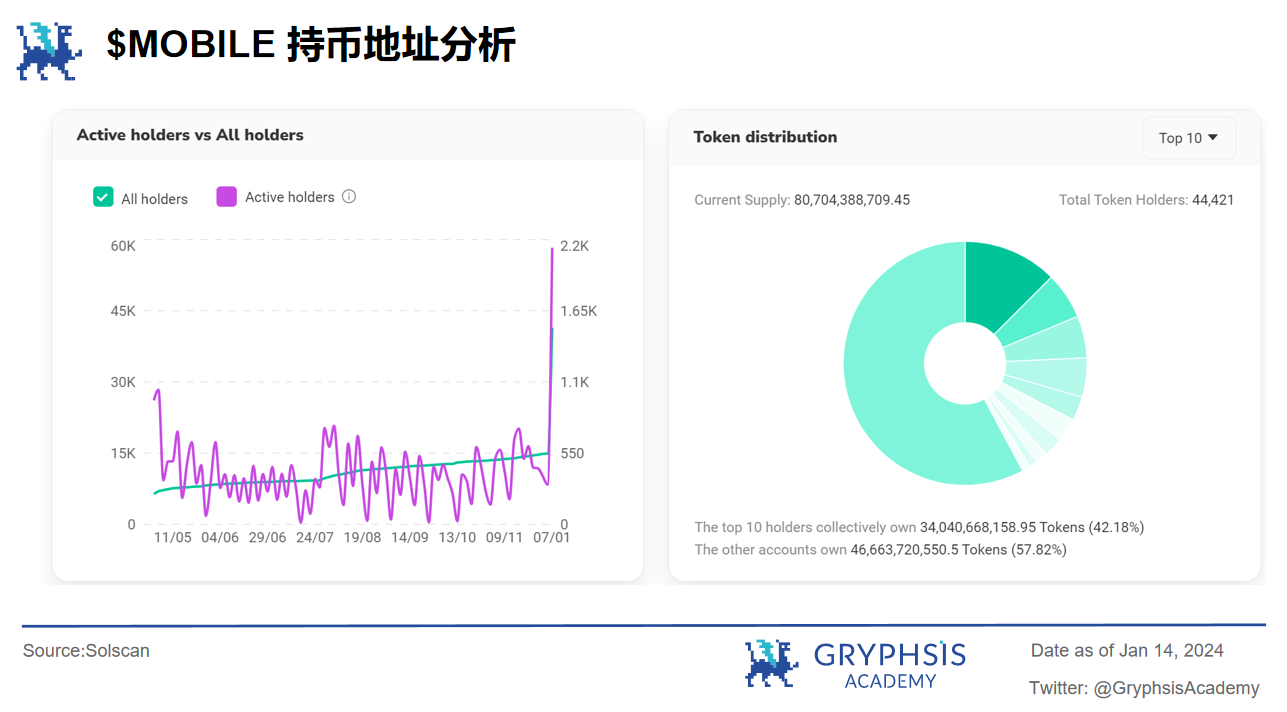
3.2.3 Partners
Helium Mobile entered into a multi-year partnership with T-Mobile, one of the major players in the 5G field in the United States, in 2022, marking its important position in mobile networks. At the same time, wireless network providers such as FreedomFi, Dish, GIGSKY, Bobcat, Mosolabs, etc. have also participated in the construction of Helium Mobile Network to provide network coverage.
In addition, suppliers such as FreedomFi have launched the Helium 5G series of products to help users better connect and use the Helium 5G network. Users can purchase equipment that meets standards to participate in Mobile Networks network construction.
 On January 25, Telefónica, the worlds leading telecommunications service provider, announced its cooperation with Nova Labs to deploy Helium Mobile hotspots in Mexico City and Oaxaca. The hotspots utilize the cryptocurrency-based Helium 5G network and Telefónica will offload its mobile data traffic to Helium Mobile and expand its coverage in Mexico.
On January 25, Telefónica, the worlds leading telecommunications service provider, announced its cooperation with Nova Labs to deploy Helium Mobile hotspots in Mexico City and Oaxaca. The hotspots utilize the cryptocurrency-based Helium 5G network and Telefónica will offload its mobile data traffic to Helium Mobile and expand its coverage in Mexico.
Telefónica is currently the first major wireless carrier to offer Helium Mobile hardware directly in Mexico, and the company claims to have approximately 383 million customers in Europe and Latin America.
It can be seen that from the United States to Mexico, Helium Mobile Network is constantly moving into the international market and expanding its business territory. And since every service provider and hotspot operator participating in the Mobile network needs to pledge a high amount of $MOBILE, it is also suppressing the circulation of tokens in disguise, thereby effectively stabilizing/raising the currency price.
4. Mobile Network Economic Model
The original token of Helium network is $HNT, the native token of Heliums subnet IOT Network is $IOT, and the native token of subnet Mobile Network is $MOBILE.
The Helium subnet tokens will be supported by $HNT as above, so the Helium mainnet will allocate a certain amount of $HNT based on the Utility Score of each subnet. Both $IOT and $MOBILE can be exchanged for $HNT on the Helium Wallet.
4.1 Data Credits
Data Credits (DC, traffic points) is a fuel token anchored to the US dollar. The price of 1 DC will be constant at US$0.00001. It can only be obtained by burning $HNT and cannot be transferred.
Usage scenarioData Credits:
Add hotspot: 4,000,000 DC required
Execute Add Hotspot Transaction Fee: 65,000 DC
Assertion position: 1,000,000 DC
Execute assertion position transaction fee: 70,000 DC
All transactions will be uploaded to the chain and require DC to be consumed. When the user needs it, the wallet will automatically burn equivalent network native tokens to generate DC and use it.
The networks native tokens mainly provide value for the roles on the supply side of the network, and DC provides value for the demand side of the network.
Why not directly use native tokens such as $MOBILE as tokens for online consumption, thereby expanding the consumption scenarios of tokens?
The following is my personal understanding: when the market goes down and native tokens are used as consumption tokens, it is likely that the circulation of tokens is large and the demand level is small, which leads to a drop in token prices; a drop in prices leads to the network operators income Gradually decrease, dampening participation enthusiasm; when operators continue to lose, network coverage and maintenance gradually decrease, products and services cannot meet user needs, and the demand side gradually stagnates, leading to further price declines, thus forming a vicious cycle.
However, since the single price of DC is stable, even if the above-mentioned market decline occurs, both the Supply side and the Demand side can exchange tokens for DC to achieve asset value preservation and even arbitrage. For example, when the market is down, DC is converted into a large amount of $MOBILE, and then converted into DC when the price picks up. It is equivalent to acting as a stable currency, thereby effectively reducing the negative effects caused by changes in market conditions.
Users of IoT and Mobile networks need to exchange $IOT and $MOBILE tokens into $HNT in the Helium Wallet App, and then burn $HNT to exchange for DC. There is no burning scenario for $MOBILE and other subnet tokens themselves.
4.2 $MOBILE
$MOBILE is the token of Helium Mobile Network, with a total supply of 230 B. 50B of these are pre-allocated when Mobile Network starts. $MOBILE adopts an emission reduction mechanism. The specific rules are as follows:
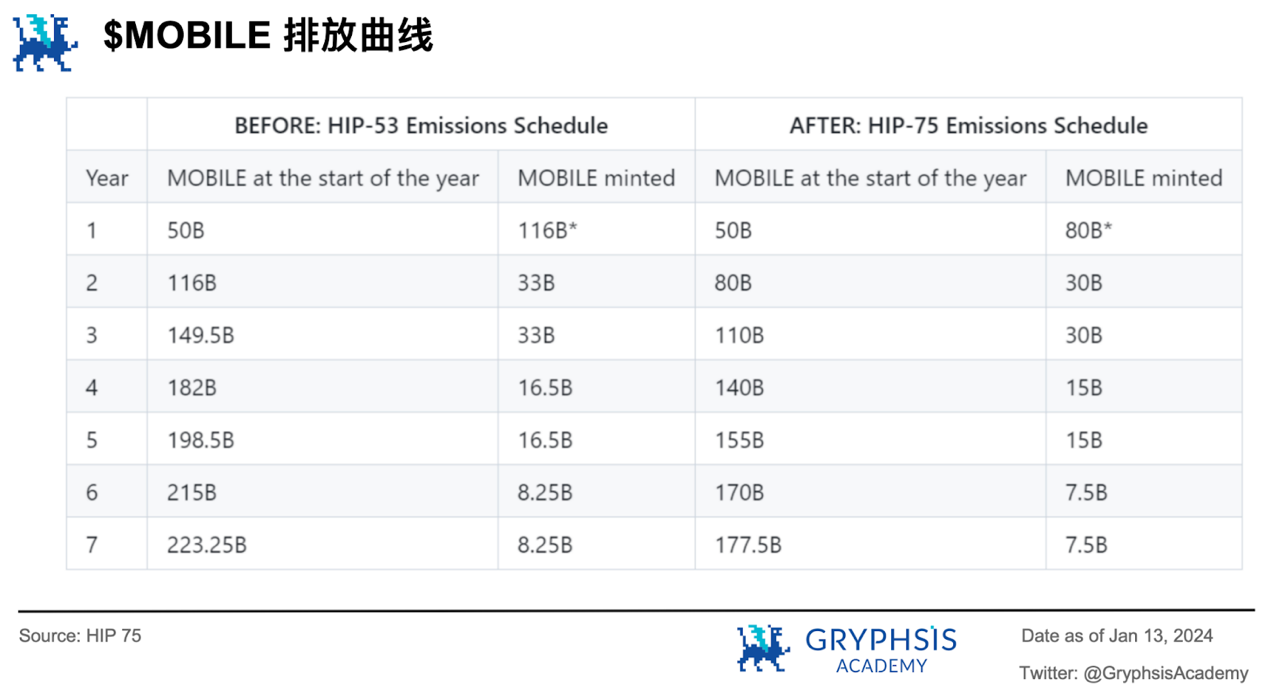
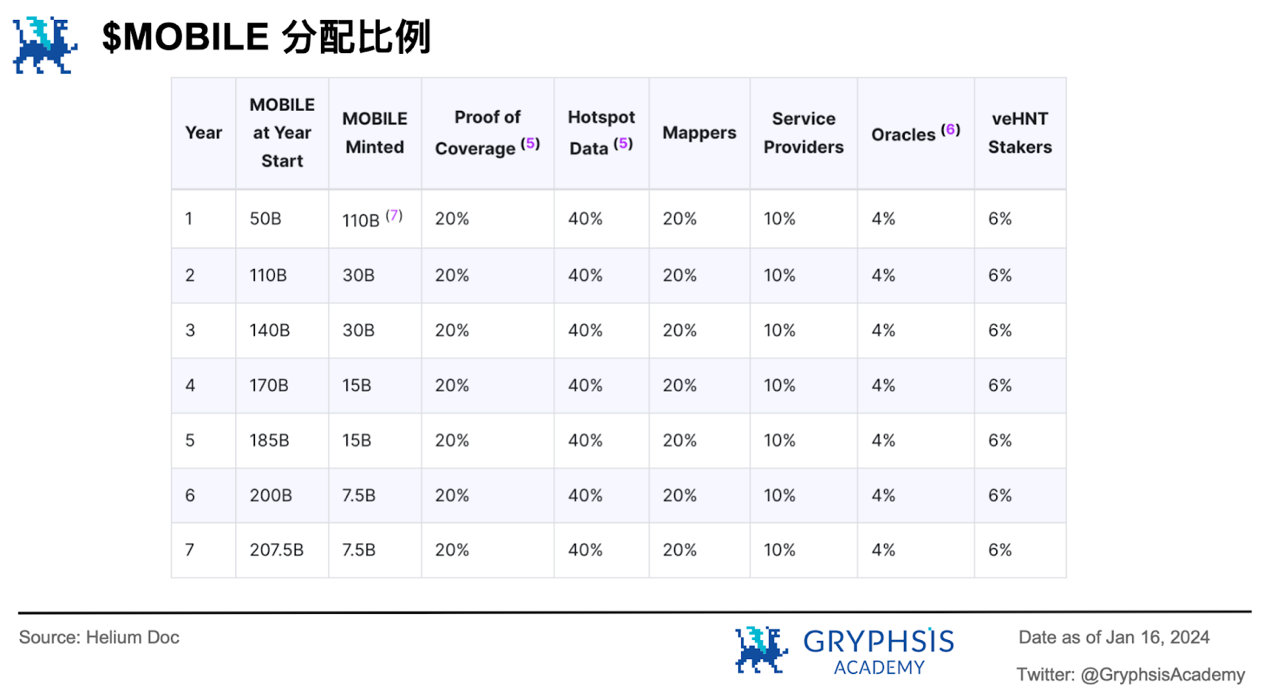 The emissions of $MOBILE are mainly allocated to nodes supporting POC proofs, 5G hotspot holders, mappers (Helium Mobile), service providers, oracles and veHNT stakers. All allocation proportions (temporarily) do not change with the reduction mechanism, and are mainly allocated to 5G hotspot holders, with strong incentives.
The emissions of $MOBILE are mainly allocated to nodes supporting POC proofs, 5G hotspot holders, mappers (Helium Mobile), service providers, oracles and veHNT stakers. All allocation proportions (temporarily) do not change with the reduction mechanism, and are mainly allocated to 5G hotspot holders, with strong incentives.
Main sources of acquisition:
Network participants: including hotspot provider POC coverage incentives, validators...
Helium Mobile: Mapper Subscription Service
Network Staking Rewards: Verifiers maintain network security and receive rewards by staking $MOBILE
Main consumption scenarios:
Onboard Fee
Pay for Helium Mobile subscriptions: Pay directly with earned $MOBILE
In order to improve the Utility Score of Mobile Network, it is used to measure network usage efficiency and also determines the $HNT (Helium Network native token) emission ratio of each subDAO.
Onboarding Fees were officially introduced in HIP 53, aiming to charge startup fees for each hotspot host, mainly including Hotspot Addition Fee and Assert Location Fee.HIP 96 In , Onboarding Fees were updated to a standardized entry fee structure for network participants, and Assert Location Fee was canceled in HIP 97.
Indoor WiFi AP: Total Onboarding Fee ($20), consumption of 1 M DC ($10 of $HNT) + $10 of $MOBILE
Outdoor WiFi AP: Total Onboarding Fee ($30), consumption of 1 M DC ($10 of $HNT) + $10 of $HNT + $10 of $MOBILE
Classification according to different levels and types of equipment to meet the ever-expanding needs. At the same time, it further expands the consumption scenarios of $MOBILE, and also brings additional benefits to the entire Helium network, making the standards of all subnetworks unified.
4.3 $MOBILE Value Capture
In addition to the above consumption scenarios of $MOBILE, currently, the main feedback benefit of $MOBILE to users is governance voting. Users can obtain $veMOBILE by staking tokens, and $veMOBILE holders can propose and vote to achieve network updates and governance.
$veMOBILE cannot be transferred. Governance rights are weighted according to the number and time of $veMOBILE locked by the user; a maximum of 4 years of locking can obtain 100 times the governance rights, and a minimum of 6 months can obtain 1 times of governance rights.

5. Track analysis
5.1 Track Overview
DePIN (Decentralized Physical Infrastructure Network) is a centralized physical infrastructure network that uses tokens to encourage users to share their idle resources including space, communication broadband, storage, computing, etc. to build an infrastructure network.
Traditional information and communication technology fields, such as hardware, software, cloud computing and data storage, as well as communication technology, are all monopolized by large institutions to a certain extent, leading to increased industry barriers. The competition threshold for small and medium-sized enterprises is too high, which is not conducive to the prosperity of the industry. develop.
Through the crowdsourcing model, DePIN allows any user with idle computing resources to participate in the construction of infrastructure. From the bottom up, it lowers the threshold while improving the breadth of services, and jointly builds a physical infrastructure network. Currently, DePIN is mainly divided into three categories: computing storage, software providers, and remote communications.

Mobile Network belongs to the Wireless radio track in remote communications in the DePIN industry. According to the Messari report, the Wireless radio track is currently larger than the computing storage market, with a compound annual growth rate of 30% -35% and no downward trend.
Annual global wireless revenue reaches 1.5 T+, of which Mobile Network accounts for 70%. It can be seen that Heliums own development prospects are optimistic, and its Mobile Network is expected to become the main force in promoting Heliums development.
5.2 Competition projects
5.2.1 Pollen

Launched in February 2022, Pollen aims to build a decentralized mobile network focused on privacy, anonymity and freedom. Disrupting the traditional centralized mobile network model by empowering users to build, own and operate decentralized network infrastructure using blockchain, CBRS and other open source technologies.
Heres how it works:
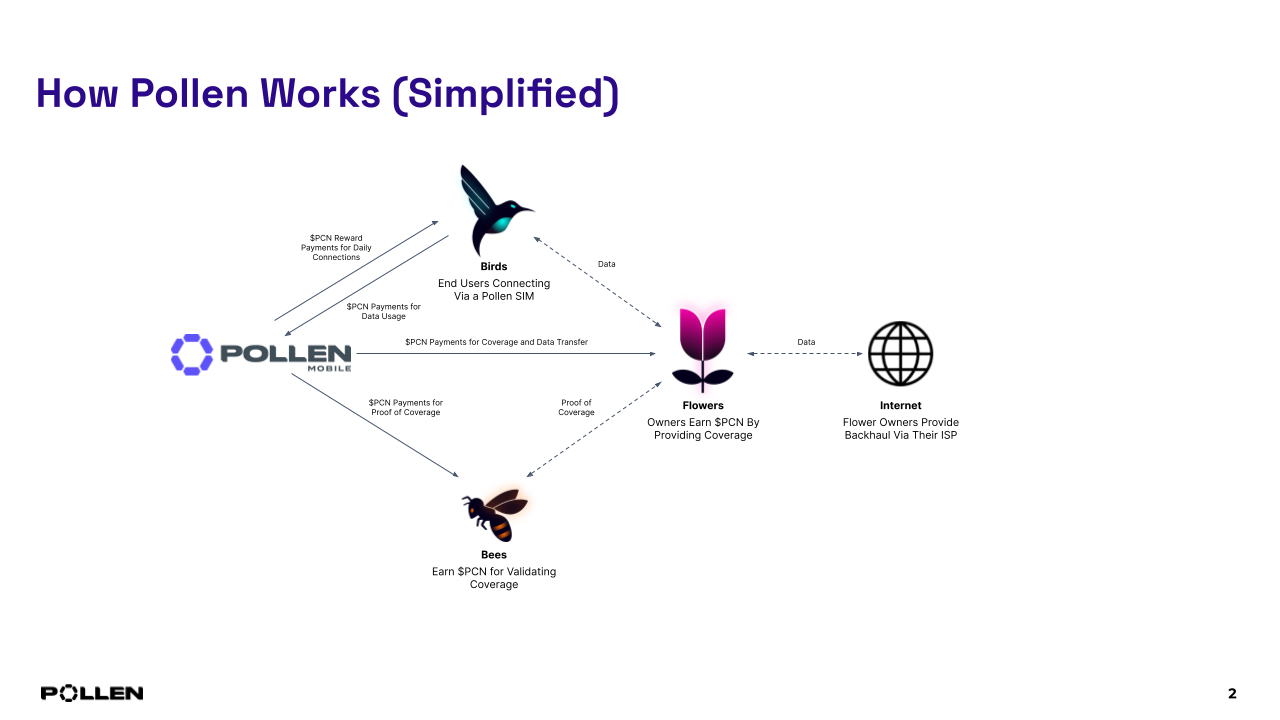
Network participants are mainly divided into the following parts:
End users (Birds): End users use devices such as phones that can connect through the Pollen network. CBRS-compatible devices can download the Pollen eSIM or purchase a SIM card to become a Bird and connect to the Pollen network.
Validators (Bees): Bees validate network coverage for Pollen and other networks by moving in the physical world and reporting coverage statistics, equivalent to a POC proof.
Network Providers (“Flowers”): Flowers provide network coverage via base stations/antennas and are incentivized by $PCN tokens.
The native token of the Pollen Mobile network, $PCN, has a total supply of 1 billion and is mainly used for the following purposes:
1) Payment within the Pollen network (such as data subscription, hardware purchase, etc.)
2) Reward Flower owners who provide network coverage
3) Reward validators to verify Flower coverage
4) Reward end users for using the network
Business classification business model:
Pollen Mobile Hybrid Network Operator (“MHNO”): centralized RAN deployment in areas lacking coverage by existing mobile network operators (“MNOs”); combined with RAN deployment of fixed radio and public/private networks; leveraging existing MNO commercialization agreement launches better services.
Fixed Wireless Access/Wireless Internet Services: Pollen will make it easy and affordable for anyone to deploy wireless Internet access. Once deployed, Pollen installations utilizing CBRS (and other mobile bands) will also be able to support mobile services such as Pollen MHNO.
Public/Private Hybrid Networks: Pollen is designed to enable anyone - from individuals, to small and medium-sized businesses, to the largest enterprises - to affordably deploy private networks at any scale.
Pollen MHNO: Charged to MNOs and Mobile Virtual Network Operators (“MVNOs”).
5.2.2 xNET
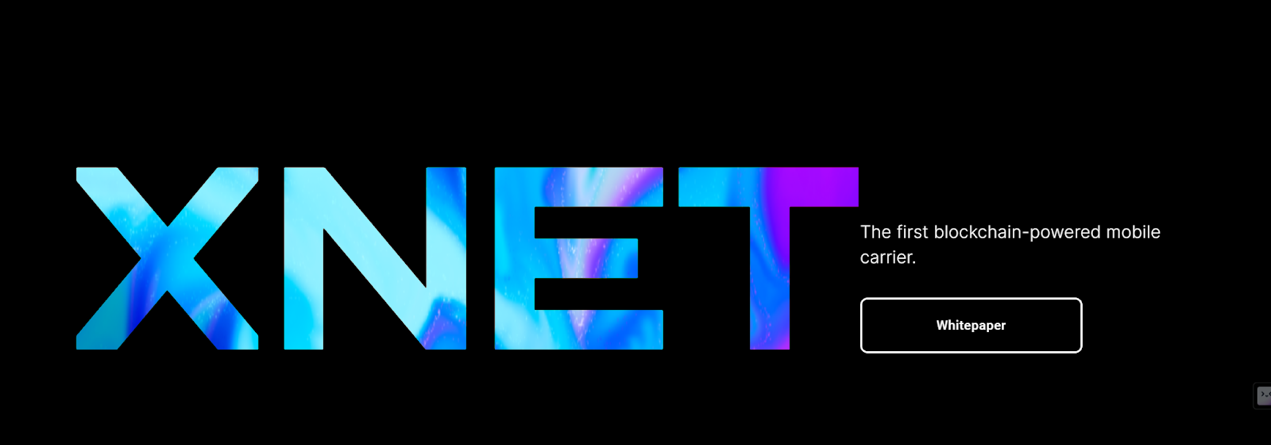
XNET is deployed on Polygon and uses blockchain technology, CBRS and a community of network operators to bring true mobile wireless 5G connectivity to consumers and enterprises. XNET will leverage CBRS and any other available radio spectrum to modernize 4G and 5G wireless networks, owning and operating XNETs wireless network infrastructure in the form of crypto rewards.
Unlike Helium and other CBRS radio competitors, XNET will provide a full-service voice and data network and operate as a true mobile network operator. In the simplified diagram below, you can see three different types of XNET network nodes and a collection of network clients, including clients that act as validators for the XNET network, coordinating the individual nodes through a public blockchain to act as a mobile network.
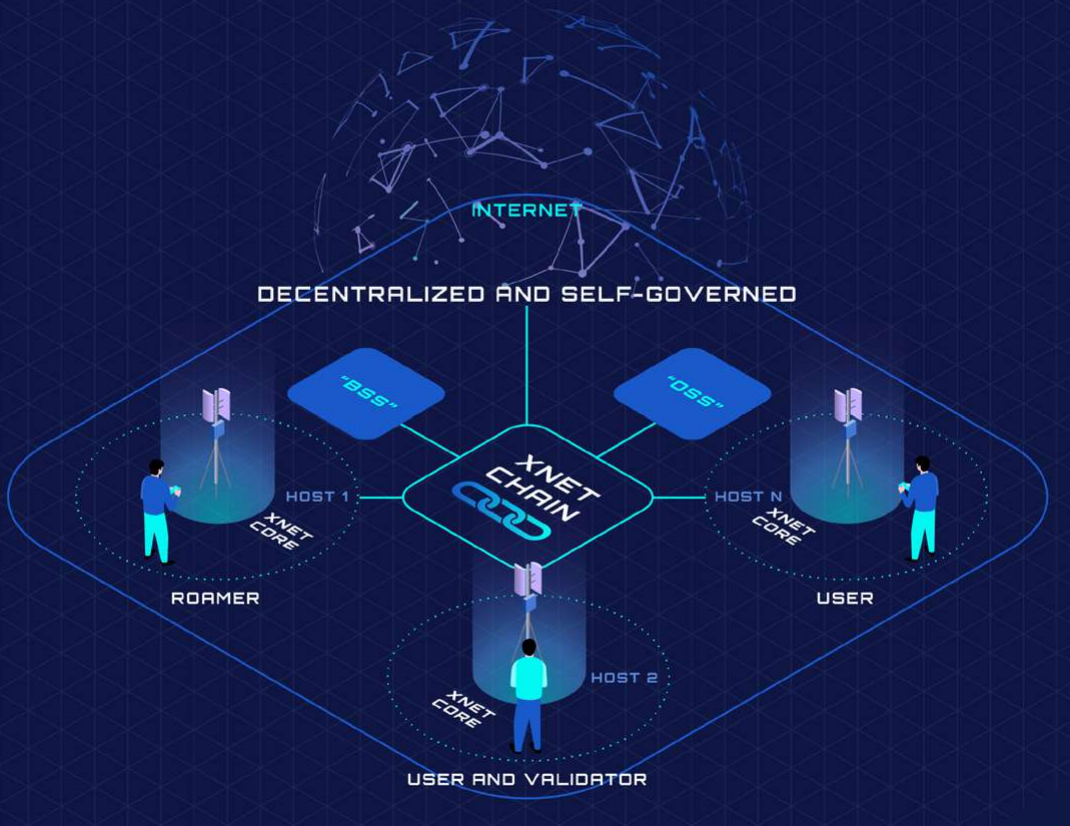
There are two types of it, the native token $XNET (the total supply is capped at 24 Billion) and the network payment token $XNETD
$XNET: The total supply is capped at 24 Billion, mainly used to incentivize nodes and validators for network maintenance
$XNETD: can only be obtained through $XNET conversion. By burning existing $XNET, users can pay network interaction fees, such as data or voice service fees.
5.2.3 Comparison and summary
We made a simple comparison between the three. Mobile and Pollen are both deployed on Solana, while xNET is deployed on Polygon. Solana is currently in the leading position on the DePIN track; Mobile Network has rich business lines, in addition to basic 5G mobile network connection, as well as additional collection subscription services and other Service Providers to accelerate network coverage and usage.
Pollens token not only incentivizes network contributors, but also incentivizes network users, including the network usage fee that users need to pay, which is also $PCN. It is more special. Both Helium and XNET use second tokens as network payment media. Looking at network usage data, Mobile Network still dominates, with its hotspot operators and network usage far surpassing its competitors.

6. Conclusion Risk Warning
Advantages:
Solana ecological bonus: The current strong momentum of the Solana ecosystem has brought many bonuses to Helium, such as Solanas Saga mobile phone. More and more projects are providing airdrops to users with mobile phones, further increasing purchase demand, and the number of users continues to grow. At the same time, the number of Mobile Network users is also expanded.
Mobile networks have low barriers to use and fast coverage, and cover very rigid needs in peoples daily lives. Therefore, although the Mobile network was launched later than the IoT network, the current network usage requirements have far exceeded the IoT, and the Mobile Network has undoubtedly become a strong driver of Helium in building user awareness.
Rich ecological partners: Establishing partnerships with many leading operators to quickly achieve business deployment and expansion is conducive to consolidating the industry position in advance.
Helium completed the proof-of-concept of DePIN in the last cycle and learned experience through many pitfalls. In the new cycle, Helium is expected to gain new growth by stepping on stones.
Disadvantages:
There are many equipment restrictions, which raises the threshold for participation: In Helium, users do not contribute to the network through their own idle resources, but need to purchase equipment that meets standards to participate. This also led to a certain period when the price of equipment was very high and the costs for operators continued to increase.
There are regulatory risks: Since different blockchain networks are affected by different regulatory policies, Heliums migration to the Solana network may bring new regulatory risks and legal requirements.
References
[ 1 ]https://dune.com/browse/dashboards?q=mobile
[2]https://www.eet-china.com/mp/a178074.html
[3]https://heliumchina.gitbook.io/helium/
[4]https://docs.helium.com/tokens/hnt-token
[5]https://blog.helium.com/a-new-era-for-helium-begins-with-upgrade-to-solana-blockchain-88b742276ec1
[6]https://explorer.helium.com/
[7]https://solana.com/news/case-study-helium
[8]https://www.sohu.com/a/ 642889492 _ 212355 khttps ://realms.heliumvote.com/dao/hnt
[9]https://realms.heliumvote.com/dao/IOT
[10]https://github.com/helium/HIP/blob/main/0025-validators.md
[11]https://tokenterminal.com/terminal/projects/helium
[12]https://dune.com/helium-foundation/helium-data-credits
[13]https://docs.pollenmobile.io/pollen-mobile-docs/white-paper/pollen-economics
[14]https://www.xnet.company/files/Whitepaper.pdf
[15]https://tokenomicshub.xyz/helium
[16]https://medium.com/helium-foundation/what-you-need-to-know-about-hip-52-and-hip-53-aaa2c 51307 a 2
[ 17 ]https://www.blocktempo.com/hip-70-helium-core-team-proposes-to-migrate-to-solana/
[Statement] This report is produced by@GryphsisAcademys student@auggest_cryptoCompleted original work, tutored by Gryphsis Academy@CryptoScott_ETH and@Zou_BlockGive suggestions for modifications. The authors are solely responsible for all content, which does not necessarily reflect the views of Gryphsis Academy, nor the views of the organization that commissioned the report. Editorial content and decisions are not influenced by readers. Please be aware that the author may own the cryptocurrencies mentioned in this report. This document is for informational purposes only and should not be relied upon for investment decisions. It is strongly recommended that you conduct your own research and consult with an unbiased financial, tax or legal advisor before making any investment decisions. Remember, the past performance of any asset does not guarantee future returns.